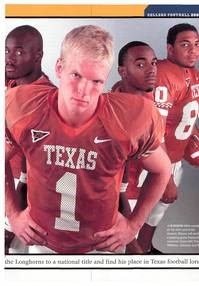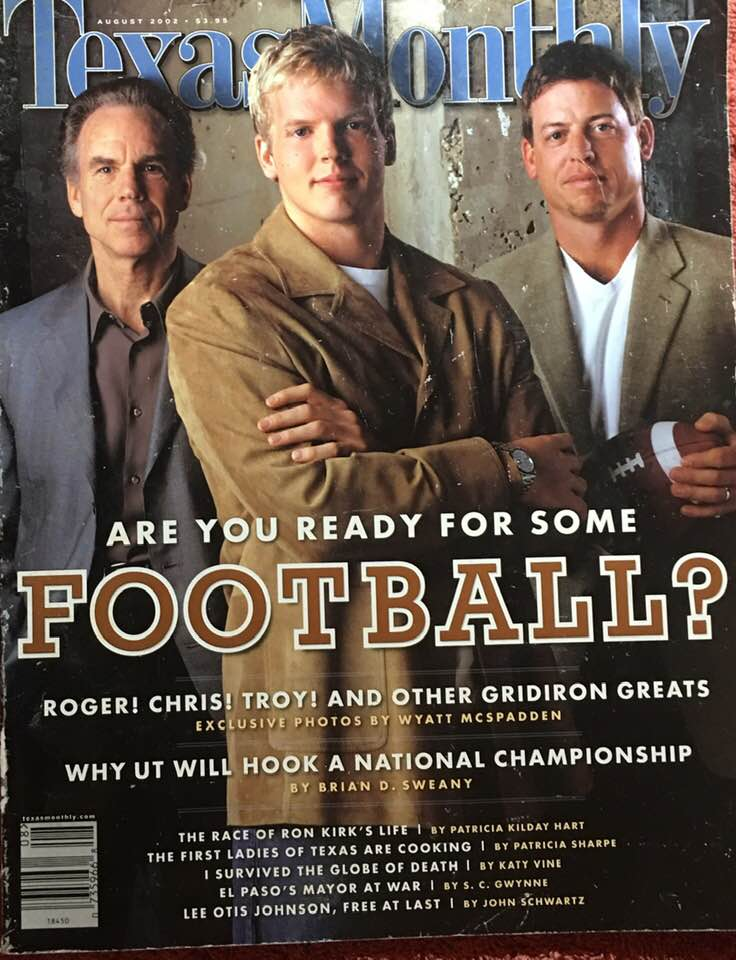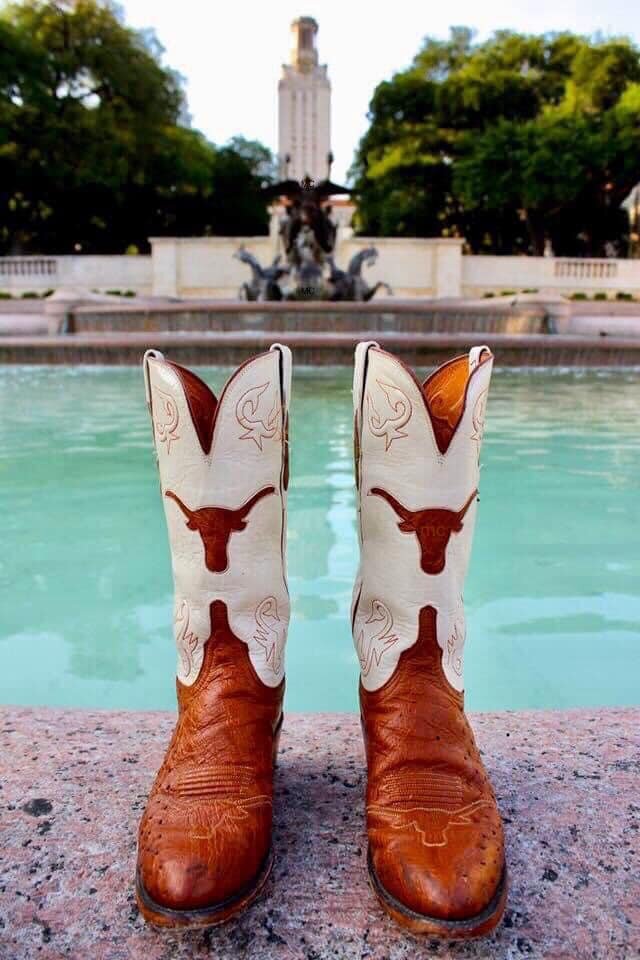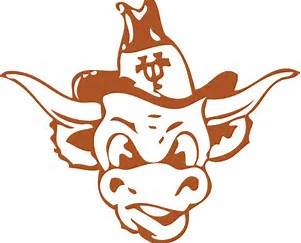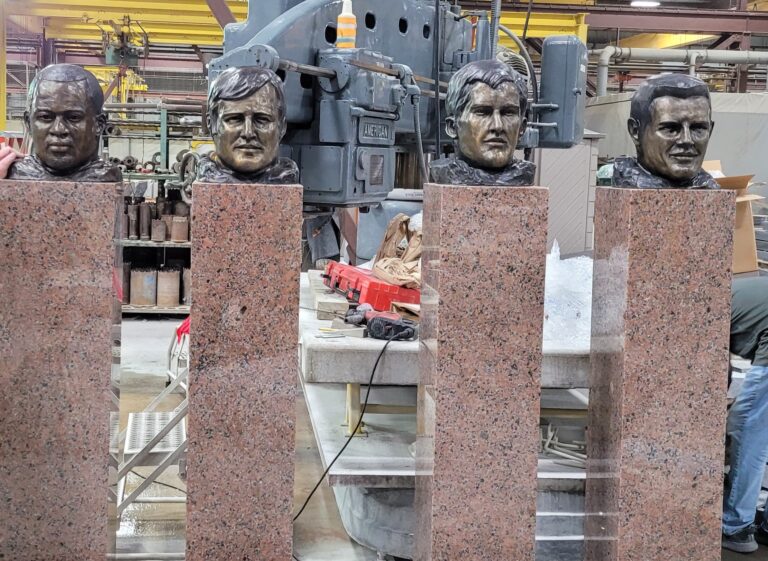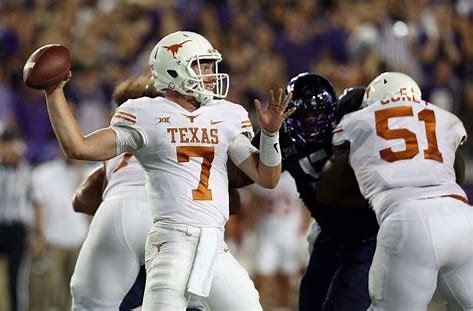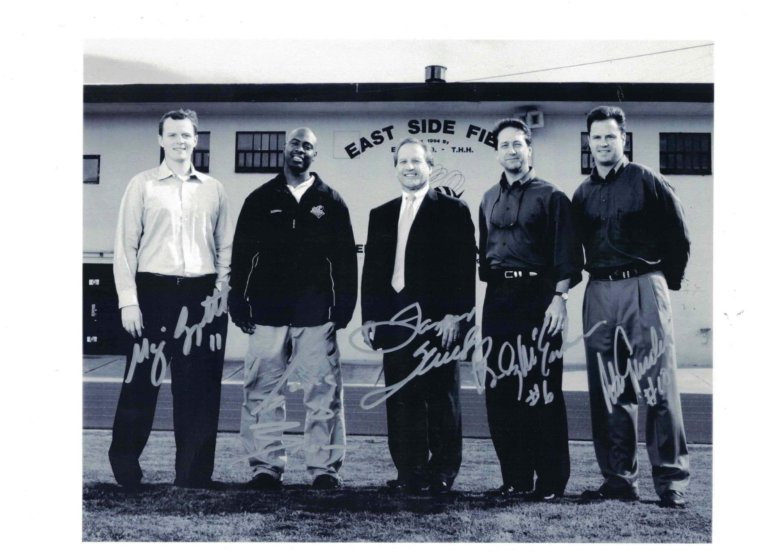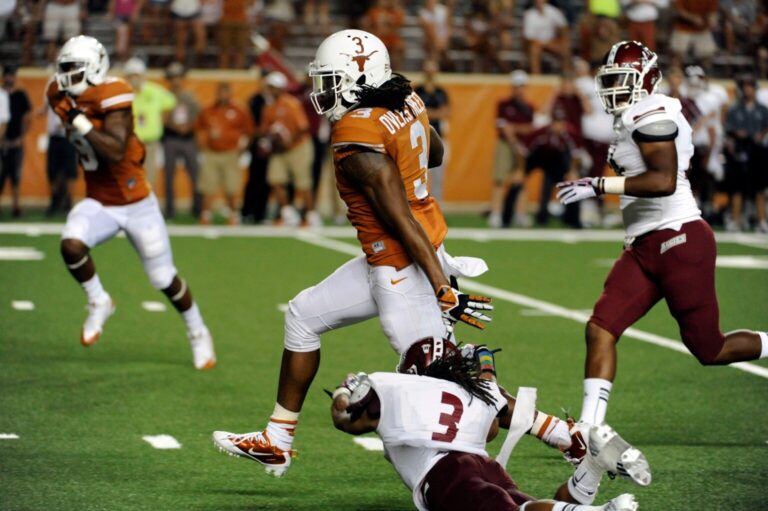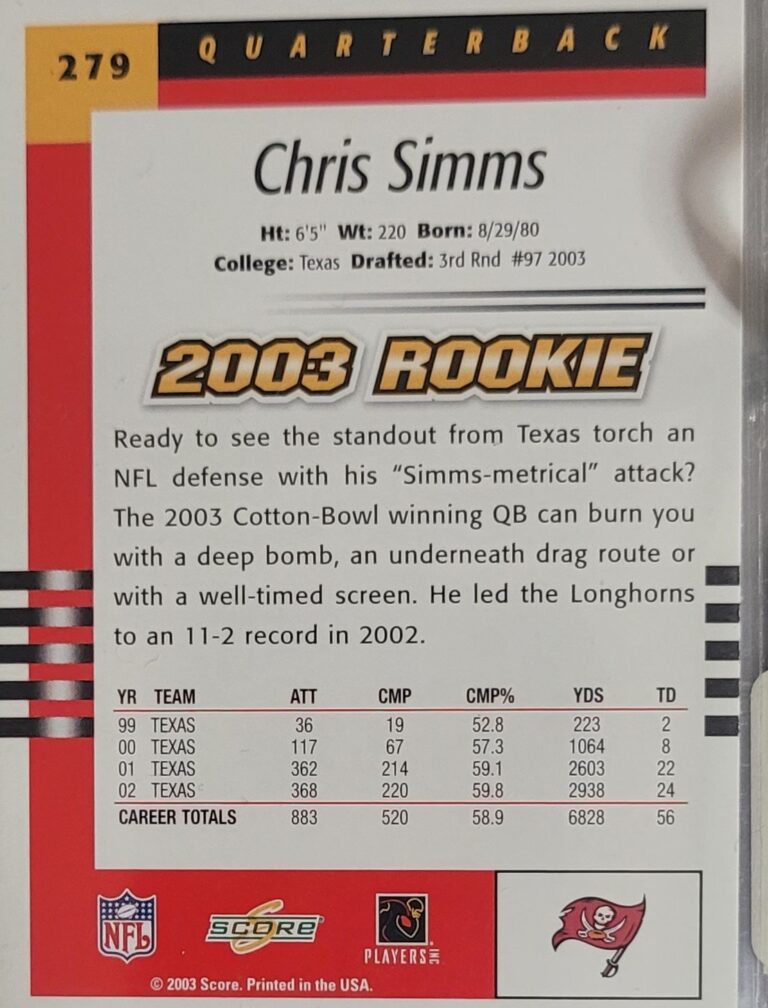Chris Simms
Everything about Simms seemed golden. Members of the Longhorn team had voted him Mr. GQ, with shiny blonde hair and bright eyes to compliment his genuine smile. If that was not enough, he was also handsome and cosmopolitan with the innocence of a back country boy.
Chris Simms
1999- Chris starts 1 game and loses.
2000- Simms starts 6 games for a season record 5-1.
2001 Chris starts 12 games for a 10-2 record.
2002 Simms 13 game for an 11-2 record.
Kirk Bohls: “Applewhite was the freckle-faced wonder who could do no wrong. Those same fans may never forgive Mack Brown for starting Chris Simms over Applewhite for Major’s senior season after Major was coming off knee surgery following the bowl game. Major had a fire and a presence that willed him to succeed. He was the stereotyped coach on the field.”
Kirk Bohls: “Chris may have been the most booed and vilified player in school history but still won 26 games as a starter. He handled himself with grace and class. While he was never the most clutch performer, he put up big numbers, won many games, and never really got his due. Against lesser opponents, Simms was at his best.”
STEER CRAZY CHRIS SIMMS IS ALL FOOTBALL, ALL THE TIME IN HIS FERVENT QUEST TO QUARTERBACK THE LONGHORNS TO A NATIONAL TITLE AND FIND HIS PLACE IN TEXAS FOOTBALL LORE
By Austin Murphy
August 13, 2001
Below is a paraphrased article in Sports Illustrated dated August 2001. I have added my thoughts on Austin Murphy’s great article about Chris Simms in bold black font.
From Wikipedia -He spent his freshman year as the backup to Major Applewhite and saw limited playing time until the end of the season. Going into the Texas A&M game (the so-called Bonfire Game as it followed the tragic death of 12 students during the construction of A&M’s annual bonfire), Texas was ranked #5, but right before that game, Applewhite got an intestinal virus that kept him up all night and required him to be put on an IV the next day. As a result, Simms got his first career start and had the Longhorns up 16–6 at halftime. After Simms struggled in the 2nd half with Texas still ahead, he was replaced by Applewhite in the 4th quarter. Still, Applewhite could not get Texas any points, they fell behind in the last 6 minutes, and Applewhite fumbled on their last possession. Simms took over again during the Cotton Bowl when Applewhite suffered a knee injury in the 4th quarter.
The next year Simms gets his first start as a Longhorn and throws an interception returned for a touchdown. Coach Brown then replaces Simms with the record setting Applewhite. Over the next three games the quarterbacks split time, but Chris is officially demoted to the second team after the OU game. Four weeks later, Applewhite sprains his right knee against Texas Tech and enters the game, and his struggles continue. Against Kansas the next week, he throws another interception that is returned for a touchdown. Leaving the field after the interception, he returns to the sideline and says to Brown, “Can you believe that?” With Applewhite on crutches, Simms knew he could screw up royally and not get the hook. So he relaxed and played his best football of the season, leading the Longhorns to a 51-16 rout. Two weeks later, with his confidence soaring, Simms completes 16 of 24 passes for 383 yards, three touchdowns, and no interceptions in a 43-17 win over Texas A&M. For the first time in two years at Texas, he’d lived up to his billing. The Golden Boy was golden. “I wasn’t golden,” he corrects. “I was pretty good.”
What happened to change his attitude?
THERE IS NOTHING GOOD ABOUT Fear of Failure and TRYING TO BE PERFECT.
Psychologists say living with a fear of failing usually thwarts an individual’s mental and social development and reduces their quality of life. Seeking perfection in life is a personal liability, not an asset. Athletes who strive for perfection and are not happy with a score assessed by the position coach after a game rating of 9.9999 instead of 10.0 are setting themselves up for a miserable and pressure-filled life.
Augie Garrido said winning should never determine your self-worth. He noted that athletes whose “character is forged in failure” are usually more prepared for college baseball than high school recruits who have only experienced winning. Augie says failure can be as positive as winning. His book “Life is Yours to win” states that failure has benefits. “If you handle failure with the right attitude, it can lead to success.” Making mistakes is how we learn lessons.
On the TLSN website, there is an article that discusses the problems with perfection. Here is the link. THE GOOD, BAD, AND UGLY OF OVERACHIEVING (squarespace.com)
Austin Murphy with Sports illustrated says, “Chris Simms was trying to meet his own self-inflicted expectations.” His roommate Babers recalls a conversation with Simms and Scaife, the tight end. “We were talking about the NFL, talking about cars and houses and stuff. Chris asked Babers, ‘Do you want to be the best corner ever?’ I told him, ‘To be honest, no. I just want to play in the league, make a little money, take care of my family.’ Chris says, ‘I wouldn’t waste my time playing if I didn’t want to be the best ever.” Babers responds to the reporter, “It’s crazy how high he’s set the bar for himself.”
#1 Chris Simms
For the most part, however, Simms was trying too hard to make a big play–“forcing the ball into cracks,” says Davis, the offensive coordinator. Adds Babers, “He knew if he didn’t move the team in two series, one of the best quarterbacks in college football (Major Applewhite) was waiting in the wings.”
Psychologists say Living life with a fear of failing usually thwarts an individual’s mental and social development and reduces their quality of life by extension. Athletes who are not happy with a score assessed by the position coach after a game of 9.9999 instead of 10.0 are setting themselves up for a miserable and pressure-filled life.
There is self-awareness in Simms, and he finally adjusts his thinking from wanting to be the best athlete ever to an athlete able to control his negative impulses when he is imperfect. This new perspective helped Chris perform with less anxiety and more self-confidence during competition.
Here are Chris Simms Longhorn records.
Texas – Most Touchdowns, Season (26), tied by Vince Young in 2005, surpassed by Colt McCoy in 2006
-
Texas – Most Touchdowns, Game (5) tied with James Brown, surpassed by McCoy in 2006
-
Texas – Most 400-yard passing games, Season (1), tied with Major Applewhite and McCoy
-
Texas –Most 400-yard total offense games, Season (1), tied with Applewhite, surpassed by Young
-
Texas – Most 400-yard total offense games, Career (1), tied with Applewhite, surpassed by Young
-
Texas – Passer Rating, Career (138.4), surpassed by McCoy 2009
Fans who booed him in previous years at the A & M game in 2001 reward with a standing ovation for a great season. He finished his career as the 2nd winningest quarterback in UT history to that point in Longhorn football with Bobby Layne #1.
B.J. Johnson shares his story about the loss to Colorado in Mike Roach’s book The Road to Success, saying, “But the way people treated Chris after … was just horrible. To treat a 20-year-old kid like that just because we lost a football game” is sad and shameful. He won’t go back to Austin to this day. He left as one of the winningest quarterbacks in UT history, and people hated him.”
Rod Baber chimes in, “There is no question that Simms “in big games would underachieve.” “Some of the younger guys had issues with Major,” and some teammates did not enjoy that Chris was born with a silver spoon in his mouth. “They thought he was given everything….. “Each quarterback had their own cultural identity, and both are still ranked in the top 5 quarterbacks to play for the Longhorns, but on game day, Rod Babers felt that Mack leaned toward Chris Simms more times than Applewhite.
Adam Ulatoski
#74 Adam Ulatoski is a Longhorn benchmark. Adam has proven to be a team player both in sports and in his professional life. As a Longhorn football player, he was nominated by his teammates three years in a row as the most “Tenacious” player on the team. A moniker earned the hard way through a herniated disc, back ailments, elbow injuries, and knee complications.
Adam’s last year as a Longhorn was in 2009. We met each other in 2015 over coffee. As we shared football experiences, I had this feeling there was something exceptional about Adam, but I could not articulate my intuition. On June 5, 2018, Adam and I met again for breakfast, and the answer I could not articulate in 2015 was now very apparent. Adam Ulatoski owns a special place in the history of Longhorn football. Including his 2005 Redshirt year, Adam is one of Texas’s only players to share workouts with two of the best quarterbacks in UT history -Vince Young and Colt McCoy. He is also one of the only Longhorn players that participated in the best 5-year record ever in Texas football with a 57-8 won-loss record. Adam has come closer to being part of three national championship games than any player in Longhorn football’s history. In 2008, the last play of the game (Texas Tech) ruined a Longhorn National Championship bid, but history honors Adam for two journeys to the National Championship game- As a redshirt against USC and a starter against Alabama.


